- Administrator
- Albums and Singles
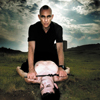 This is the long-delayed sequel to the mad Welshman's 2003 Double Vulgar album, which was intended to follow closely upon the release of the first, but because of various problems surrounding the pornographic artwork and the dissolution of World Serpent Distribution, it has been delayed until now.
This is the long-delayed sequel to the mad Welshman's 2003 Double Vulgar album, which was intended to follow closely upon the release of the first, but because of various problems surrounding the pornographic artwork and the dissolution of World Serpent Distribution, it has been delayed until now.
Released as a CD and a triple-LP on Beta-Lactam Ring, the music on Thighpaulsandra's Double Vulgar II is very much in the same vein as its predecessor: long, freeform post-prog soundscapes populated by a basement full of vintage analogue synthesizers, long passages of masturbatory noodling, occasionally erupting into grandiose psychedelic glam-rock centerpieces before giving way to the twittering machines again. The album opens with Thighps and his opera-singing mum Dorothy Lewis trading surreal quips. "I'm not above using these tongs, you know," says Mme. Lewis, to which her son replies: "You afro-intercom bitch!" This weirdness continues for a while, against a backdrop of vaguely Star Trek-ian electronic chirps and the mutated saxophone bleats. The track continues through very surreal territory, sounding not entirely unlike something Nurse With Wound would produce after listening to the entire discography of ESP-Disk under the influence of magic mushrooms. I kept thinking that the song was on the verge of coalescing into something more concrete and musical, but I was wrong—dead wrong—which is good. It's nice to have your hopes and expectations dashed occasionally. "Telly For Rex" is something else entirely, sounding like the group improvisations captured on last year's Rape Scene album.
The trio (or quartet?) of players orbit loosely around Thighpaulsandra's noisy squalls of brain-frying electronics, trying to glue it all together with shambolic percussion and swathes of electric guitar. It's a gloriously incomprehensible mess, all the way up until about the 13-minute mark, at which point the song unceremoniously explodes into a ferocious Hawkwind-style space-rock bacchanalia, complete with incongruous female back-up vocals. Things don't get any clearer with "Imperial," which begins quiet and clattery before gradually turning into an inexplicably groovy jazzy Krautrock with xylophones and all manner of unexplainable audio phenomenon bouncing around the room. Then it gets quiet and creepy again, concluding with a distorted group incantation. "Vomitting Child" begins with the sounds of closely-mic'd droids quietly masturbating, before turning into a vaguely tribal excursion, eventually somehow ending up as a melancholic, spaced-out alt-country number complete with slide guitar and mellow vocals by Thighpaulsandra himself. Ending this kitchen-sink mess is the hilariously over-the-top "Bost Sanvay Unst Bit Sumonver," a truly unhinged sidelong track that begins with a sorta coherent song-type-thing with perverse lyrics ("I wipe my penis on his curtains") and gradually falls apart into its component pieces, wandering lysergically through several deeply fucked-up minutes before reassembling for a final rhythmic leap into space. Double Vulgar II is the sort of album that plays like an uncensored, unedited stream-of-consciousness from a group of talented players being led by a mad genius. It makes no apologies for its excesses (including the erect male member lovingly pictured on the back sleeve), and doesn't stay in one place long enough for anyone to get bored.
samples:
Read More
- Lucas Schleicher
- Albums and Singles
Carpark
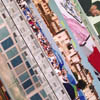 Far moreglitchy and filled with non-linear messes of static and random noise,the majority of Yearlonghas a less polished and more improvised structure than what I amaccustomed to from either composer and so, upon first listen, I was abit shocked by what I was hearing. The first Knitting Factory track isbasically a series of highly edited pulses forced into envelopes ofecho, reverb, sudden decompression, and 90 degree turns. There's verylittle room for continuity. Similarly, the recording from the Bottom ofthe Hill in San Francisco comes off as a noise performance edited anddisjointed on the spot; gone are the smooth curves that populated bothDavis' and Whitman's releases from last year. On the other hand, thetwo WFMU Radio pieces and the Kontor Gallery recording in Köln, Germanyfit together quite well: the bells, whistles, reversed signal hums andguitar samples all flow in and out seamlessly, as though they weremeant to sit side by side on a disc. The La Casa performance inWashington is a beautiful mix of kitchen sink percussion and simple,spacious piano bits and the massive WNYU-FM track from New York(recorded on the same day as the Washington performance) is a blissfulmix of contemplative bells and shuffling utensils. These two tracks, inparticular, are amazing because of how different they are. Recorded onthe same day, they're indicative of how diverse both composers are andjust how willing they are to try new ideas. The Impakt Festivalrecording, the last track on the disc, is particularly fun, too, andseals my feelings on this album up. A combination of crackling hiss andmarching band samples, it lights up the end of an album that, at first,can be a little daunting, but ends up being excellently diverse andaddictive in all its playfulness. - Lucas Schleicher
Far moreglitchy and filled with non-linear messes of static and random noise,the majority of Yearlonghas a less polished and more improvised structure than what I amaccustomed to from either composer and so, upon first listen, I was abit shocked by what I was hearing. The first Knitting Factory track isbasically a series of highly edited pulses forced into envelopes ofecho, reverb, sudden decompression, and 90 degree turns. There's verylittle room for continuity. Similarly, the recording from the Bottom ofthe Hill in San Francisco comes off as a noise performance edited anddisjointed on the spot; gone are the smooth curves that populated bothDavis' and Whitman's releases from last year. On the other hand, thetwo WFMU Radio pieces and the Kontor Gallery recording in Köln, Germanyfit together quite well: the bells, whistles, reversed signal hums andguitar samples all flow in and out seamlessly, as though they weremeant to sit side by side on a disc. The La Casa performance inWashington is a beautiful mix of kitchen sink percussion and simple,spacious piano bits and the massive WNYU-FM track from New York(recorded on the same day as the Washington performance) is a blissfulmix of contemplative bells and shuffling utensils. These two tracks, inparticular, are amazing because of how different they are. Recorded onthe same day, they're indicative of how diverse both composers are andjust how willing they are to try new ideas. The Impakt Festivalrecording, the last track on the disc, is particularly fun, too, andseals my feelings on this album up. A combination of crackling hiss andmarching band samples, it lights up the end of an album that, at first,can be a little daunting, but ends up being excellently diverse andaddictive in all its playfulness. - Lucas Schleichersamples:
- Knitting Factory - New York USA - June 22nd, 2002 (Track 03)
- WFMU Radion Session - Jersey City USA - June 23rd, 2002 (Track 08)
- Bottom of the Hill - San Francisco USA - April 4th, 2002
Read More
- Administrator
- Albums and Singles
Morr Music
 For the most part, Blumm's tunes originate from guitarand bass strummings and pluckings that warmly become enveloped withinstrumental layers of harmonium, accordion, vibraphone and minimalkeyboard effects. Having devoted serious studies towards music, hisknowledge, placement and performances with such instruments has beendone very tastefully and with no discordance. Although a pop musicelement is present on the disc's compositions, the one facet notincluded (and not at all missed) is the bright tempos. Tracks such as"Nie" and "Langen" move at a slower, yet comfortable clip for pluckedguitar progressions to leave the ample space which is beautifullycolored by strokes of xylophone and blocks of harmonium with melodiesfurnished on melodica and glockenspiel. Brisker tempos would onlymuddle these brilliant and emotive performances. "Blick" consists of abase of sparse, drop-tuned acoustic guitar strumming and weavingmelodica lines propelled by subtle vibraphone flams. Already rife withcinematic-styled orchestrations and evocations, the addition of asoaring French Horn performance from Harald Ziegler seals the deal tomake this my favorite track on the disc (not to mention a new-foundrespect for the French Horn). The musically rich David Grubbs lends hisunique vocals to the disc's closing track, "Nachhall/Chroma Key," withlyrics verging on stream-of-consciousness based around the set of atelevision show. Zweite Meer is a disc of warm and amicabletunes, and as its cover suggests, is the musical equivalent of layingback on the grass and picking out cloud shapes as a lazy afternoondrifts by.
For the most part, Blumm's tunes originate from guitarand bass strummings and pluckings that warmly become enveloped withinstrumental layers of harmonium, accordion, vibraphone and minimalkeyboard effects. Having devoted serious studies towards music, hisknowledge, placement and performances with such instruments has beendone very tastefully and with no discordance. Although a pop musicelement is present on the disc's compositions, the one facet notincluded (and not at all missed) is the bright tempos. Tracks such as"Nie" and "Langen" move at a slower, yet comfortable clip for pluckedguitar progressions to leave the ample space which is beautifullycolored by strokes of xylophone and blocks of harmonium with melodiesfurnished on melodica and glockenspiel. Brisker tempos would onlymuddle these brilliant and emotive performances. "Blick" consists of abase of sparse, drop-tuned acoustic guitar strumming and weavingmelodica lines propelled by subtle vibraphone flams. Already rife withcinematic-styled orchestrations and evocations, the addition of asoaring French Horn performance from Harald Ziegler seals the deal tomake this my favorite track on the disc (not to mention a new-foundrespect for the French Horn). The musically rich David Grubbs lends hisunique vocals to the disc's closing track, "Nachhall/Chroma Key," withlyrics verging on stream-of-consciousness based around the set of atelevision show. Zweite Meer is a disc of warm and amicabletunes, and as its cover suggests, is the musical equivalent of layingback on the grass and picking out cloud shapes as a lazy afternoondrifts by.samples:
Read More
- Jim Siegel
- Albums and Singles
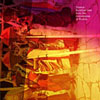 Various trumpets, handpercussion, vocals and the occasional stringed and wind instrument areused to worship deities through prayer and invocation. Levy used stateof the art recording techniques but aimed to capture events as theyhappened, therefore these recordings have an air of authenticity. Thefact that he did not bring the participants into a studio and attemptto recreate their performances also lends the set a timeless quality. Atrack simply titled "Monks" is described as "monks, clown and publicenjoyment." This two minutes of seemingly random chanting and informalvocalizing simply would not have been heard had Levy not made hisrecordings as an observer. The immediacy of the recordings gives them avisual quality. It is easy to envision layers of dust being releasedfrom ancient cymbals as they are struck together. Although the set islong at 143 minutes, it is conveniently divided into three sections:"Rituals of the Drukpa Order," "Sacred Dances and Rituals of theNyingmapa and Drukpa Orders," and "Temple Rituals and PublicCeremonies." Much of sections one and two are trance-inducing, andperhaps this is entirely the point, as this music is not being createdas entertainment. Levy was granted special access to record these ritesbased on his track record of excellence in field recordings made inother countries. While this music of Buddhism is normally only heard bythe general public on special occasions, Bhutan's folk music isperformed publicly and enjoyed by all. Many examples of this type areheard in section three, which offers a wider variety of styles than theprivate Buddhist rites heard in sections one and two. Here we aretreated to music performed during processions, festivals and dances.There are also examples of pieces for solo vocal, cymbals and flute.Music that is devotional in nature and ritualistic in practice is oneof the most pure and genuine forms of expression, and these recordingsare free of the baggage that plagues so much Western music.
Various trumpets, handpercussion, vocals and the occasional stringed and wind instrument areused to worship deities through prayer and invocation. Levy used stateof the art recording techniques but aimed to capture events as theyhappened, therefore these recordings have an air of authenticity. Thefact that he did not bring the participants into a studio and attemptto recreate their performances also lends the set a timeless quality. Atrack simply titled "Monks" is described as "monks, clown and publicenjoyment." This two minutes of seemingly random chanting and informalvocalizing simply would not have been heard had Levy not made hisrecordings as an observer. The immediacy of the recordings gives them avisual quality. It is easy to envision layers of dust being releasedfrom ancient cymbals as they are struck together. Although the set islong at 143 minutes, it is conveniently divided into three sections:"Rituals of the Drukpa Order," "Sacred Dances and Rituals of theNyingmapa and Drukpa Orders," and "Temple Rituals and PublicCeremonies." Much of sections one and two are trance-inducing, andperhaps this is entirely the point, as this music is not being createdas entertainment. Levy was granted special access to record these ritesbased on his track record of excellence in field recordings made inother countries. While this music of Buddhism is normally only heard bythe general public on special occasions, Bhutan's folk music isperformed publicly and enjoyed by all. Many examples of this type areheard in section three, which offers a wider variety of styles than theprivate Buddhist rites heard in sections one and two. Here we aretreated to music performed during processions, festivals and dances.There are also examples of pieces for solo vocal, cymbals and flute.Music that is devotional in nature and ritualistic in practice is oneof the most pure and genuine forms of expression, and these recordingsare free of the baggage that plagues so much Western music.samples:
Read More
- Chris Roberts
- Albums and Singles
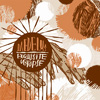 Completing the doubleentendre, the album uses a motif or montage of death and relatedimagery as its unifying principle. In doing so, Daedalus informs theworld that hip hop—the category in which Daedalus's uniquely arranged,densely-packed beat-driven sound best fits—can offer elegies far moreinvolved that merely pouring some out for one's homies. Adhering tohabit, Daedalus uses primarily analog samples of 1950s cocktail-loungesingers, ancient-sounding 1920s and 30s piano and organ notes andcheesily ambiguous post-war string arrangements as source material. Putin front of a simple snare-and-cymbal beat or a bossa-nova percussionsample, the sound of Exquisite Corpse is more akin to classicalelegy rather than a Gothic dirge: a welcome surprise as nothing isworse than a melodramatic hip hop record. And the material is no Antigone,either. After a few minutes of instrumentals to set the mood, MF Doom'srapid fire and witty opener "Impending DOOM" mates a frantic, freneticbackbeat to his signature flow, with a string sample to keep the moodslightly mellow. Two versions of "Welcome Home" hint at some sort of anauthentic cadavre exquis; a glitch-heavy beatdown that is unmistakablyPrefuse 73, and a typically thoughtful and esoteric Mike Ladd poem,read over the original Daedalus beat: "Waiting on Pompeii/ my brain's awar machine/ waiting on the next/ another shoe is another day/ long asit doesn't fall I'm ok/ welcome home." "I Sent Off" is the closest Exquisite Corpsecomes to more "typical" electronic music, the strings-and-singeropening duet fading into a dance-club worthy crescendo of gyratingbeats. Among the more notable guest appearances is the pleasing sleeper"Drops," featuring obscure MC Cyne, laying a heartfelt rap over arelaxing jazz-inspired loop. The album's zenith is "Crippled Hand," asix-minute tour de force that showcases Daedalus's ability to dowhatever he wants with any conceivable sound, from Andean pan flutes toclipper-ship era pennywhistles. In Greek mythology, Daedalus's skill asan inventer was legendary, able to manipulate anything with dexterityand aplomb. It's hard to think of a more appropriate moniker for thehip-hop Daedalus.
Completing the doubleentendre, the album uses a motif or montage of death and relatedimagery as its unifying principle. In doing so, Daedalus informs theworld that hip hop—the category in which Daedalus's uniquely arranged,densely-packed beat-driven sound best fits—can offer elegies far moreinvolved that merely pouring some out for one's homies. Adhering tohabit, Daedalus uses primarily analog samples of 1950s cocktail-loungesingers, ancient-sounding 1920s and 30s piano and organ notes andcheesily ambiguous post-war string arrangements as source material. Putin front of a simple snare-and-cymbal beat or a bossa-nova percussionsample, the sound of Exquisite Corpse is more akin to classicalelegy rather than a Gothic dirge: a welcome surprise as nothing isworse than a melodramatic hip hop record. And the material is no Antigone,either. After a few minutes of instrumentals to set the mood, MF Doom'srapid fire and witty opener "Impending DOOM" mates a frantic, freneticbackbeat to his signature flow, with a string sample to keep the moodslightly mellow. Two versions of "Welcome Home" hint at some sort of anauthentic cadavre exquis; a glitch-heavy beatdown that is unmistakablyPrefuse 73, and a typically thoughtful and esoteric Mike Ladd poem,read over the original Daedalus beat: "Waiting on Pompeii/ my brain's awar machine/ waiting on the next/ another shoe is another day/ long asit doesn't fall I'm ok/ welcome home." "I Sent Off" is the closest Exquisite Corpsecomes to more "typical" electronic music, the strings-and-singeropening duet fading into a dance-club worthy crescendo of gyratingbeats. Among the more notable guest appearances is the pleasing sleeper"Drops," featuring obscure MC Cyne, laying a heartfelt rap over arelaxing jazz-inspired loop. The album's zenith is "Crippled Hand," asix-minute tour de force that showcases Daedalus's ability to dowhatever he wants with any conceivable sound, from Andean pan flutes toclipper-ship era pennywhistles. In Greek mythology, Daedalus's skill asan inventer was legendary, able to manipulate anything with dexterityand aplomb. It's hard to think of a more appropriate moniker for thehip-hop Daedalus.samples:
Read More
- Lucas Schleicher
- Albums and Singles
Kranky
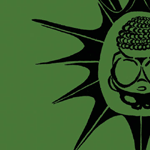 Our Bed Is Greenis a massive recording of several different styles of music, all ofwhich are only hinted at on more recent releases. Between the soft,eerie opening of "Tea" and the hissing, open sound collage aura of"Finale" is a mish-mash of country, soul, blues, and spiritual musicgrinding upon each other and unleashing a full, dense steam of tenseatmospheres and playful, melodic pictures. Songs like "Bid YouGoodnight" and "I Don't Know You" are composed of relativelystraight-forward guitar and organ phrases harmonizing togetherperfectly, with either Christina or Tom singing, but without thestrange or alien characteristics of their more recent work (think Joy Shapes).On the same CD, however, are droning and meditative guitar sonatas like"The Treadmill" and "Stuttgart." On these noise is king and the guitaris bled of every last ounce of electricity before Tom Carter eventhinks about letting it go. Crystalline notes seep through the walls ofsound that Charalambides lay down, providing a center to the chaos theysometimes unleash, and through their wails that familiar and hauntingspirit rolls out of their music. It's hard to imagine any other bandsitting such distinct musical styles side by side without soundingsloppy, but Charalambides can be quiet and spectral one moment, igneousthe next, and end up resolving themselves into a country-folk hybridthat eases on by as though it were carried on the wind. There might bemore recognizable elements on Our Bed Is Green, but the musicis undeniably unlike anything else I've heard; Charalambides wereentirely unique from the beginning. The songs on their first record arealready composed of anti-matter and numinous non-sounds, placing all ofthem well outside this world and somewhere in the nether places of mythor mysticism.
Our Bed Is Greenis a massive recording of several different styles of music, all ofwhich are only hinted at on more recent releases. Between the soft,eerie opening of "Tea" and the hissing, open sound collage aura of"Finale" is a mish-mash of country, soul, blues, and spiritual musicgrinding upon each other and unleashing a full, dense steam of tenseatmospheres and playful, melodic pictures. Songs like "Bid YouGoodnight" and "I Don't Know You" are composed of relativelystraight-forward guitar and organ phrases harmonizing togetherperfectly, with either Christina or Tom singing, but without thestrange or alien characteristics of their more recent work (think Joy Shapes).On the same CD, however, are droning and meditative guitar sonatas like"The Treadmill" and "Stuttgart." On these noise is king and the guitaris bled of every last ounce of electricity before Tom Carter eventhinks about letting it go. Crystalline notes seep through the walls ofsound that Charalambides lay down, providing a center to the chaos theysometimes unleash, and through their wails that familiar and hauntingspirit rolls out of their music. It's hard to imagine any other bandsitting such distinct musical styles side by side without soundingsloppy, but Charalambides can be quiet and spectral one moment, igneousthe next, and end up resolving themselves into a country-folk hybridthat eases on by as though it were carried on the wind. There might bemore recognizable elements on Our Bed Is Green, but the musicis undeniably unlike anything else I've heard; Charalambides wereentirely unique from the beginning. The songs on their first record arealready composed of anti-matter and numinous non-sounds, placing all ofthem well outside this world and somewhere in the nether places of mythor mysticism.samples:
Read More
- Jim Siegel
- Albums and Singles
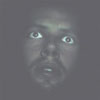 "The Meat in the Street" and thehideously-titled "The National Republic of Harelip" feature the rapid,rolling stop-start rhythms that are usually associated with so-calledIDM, but in this environment they work well to heighten the tensioncreated by layers of atmospheric synths and brooding melodies. Thismusic seems more the work of a singular vision than most melodicelectronic music, bearing evidence of human hands through the emotionalresonance of tracks like "Letter Puncture PNX Pass" and "Johnny 123.""Johnny" features irregular rhythms escaping all over the stereo field,yet is grounded by a bed of plaintive, melodic synthesizer tones andstrange vocal samples. The cut-up whispered vocals on "The Coal MineWorker" give the track a sense of pending doom that is heightened bythe eerie, claustrophobic ambience of the music. Other tracks, such as"Not Down That Alley," "Slave News," and "17 Fidelity Guards" arebeatless and evoke apocalyptic visions through introspectivesynthesizer washes. These relatively sedate pieces offer contrast tothe hectic beat programming featured on many of the other tracks, yetretain a connection to the whole by evoking a similar atmosphere ofdesolation. This contrast is one of the strengths of the album, andsaves it from being a dull collection of tracks that each pit beatsversus ambience. "Bleak Purple" is by far the noisiest track here, withshort bursts of digital detritus weaving in and out of skittery beatsthat vary from the quiet pitter-patter variety to full-on industrialstomp. The dub-inflected techno rhythms and keyboard stabs of"Lockerbroom Rumble" would sound derivative of Pole and the BasicChannel crew were they not combined with waves of sharp static andplaced within the context of the rest of these tracks. Although Nodernwas recorded in Venice, London, and Johannesburg, it doesn't sound asif it was pieced together from various sessions over a period of threeyears. None of these cities come to mind when hearing the album, asNodern has successfully created a work that is borne of his ownuniverse.
"The Meat in the Street" and thehideously-titled "The National Republic of Harelip" feature the rapid,rolling stop-start rhythms that are usually associated with so-calledIDM, but in this environment they work well to heighten the tensioncreated by layers of atmospheric synths and brooding melodies. Thismusic seems more the work of a singular vision than most melodicelectronic music, bearing evidence of human hands through the emotionalresonance of tracks like "Letter Puncture PNX Pass" and "Johnny 123.""Johnny" features irregular rhythms escaping all over the stereo field,yet is grounded by a bed of plaintive, melodic synthesizer tones andstrange vocal samples. The cut-up whispered vocals on "The Coal MineWorker" give the track a sense of pending doom that is heightened bythe eerie, claustrophobic ambience of the music. Other tracks, such as"Not Down That Alley," "Slave News," and "17 Fidelity Guards" arebeatless and evoke apocalyptic visions through introspectivesynthesizer washes. These relatively sedate pieces offer contrast tothe hectic beat programming featured on many of the other tracks, yetretain a connection to the whole by evoking a similar atmosphere ofdesolation. This contrast is one of the strengths of the album, andsaves it from being a dull collection of tracks that each pit beatsversus ambience. "Bleak Purple" is by far the noisiest track here, withshort bursts of digital detritus weaving in and out of skittery beatsthat vary from the quiet pitter-patter variety to full-on industrialstomp. The dub-inflected techno rhythms and keyboard stabs of"Lockerbroom Rumble" would sound derivative of Pole and the BasicChannel crew were they not combined with waves of sharp static andplaced within the context of the rest of these tracks. Although Nodernwas recorded in Venice, London, and Johannesburg, it doesn't sound asif it was pieced together from various sessions over a period of threeyears. None of these cities come to mind when hearing the album, asNodern has successfully created a work that is borne of his ownuniverse.samples:
Read More
- Gary Suarez
- Albums and Singles
LTM
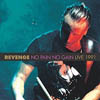 In the summer of 1989 after an extensive tour for that album, perhaps with a desire to escape from chart success and return to his Joy Division roots, Hook got into the studio with musicians Chris Jones and David Hicks to begin writing the first lackluster material for the band. In January 1990, Revenge played their first live show with an expanded lineup featuring Ash and David Potts, the latter of whom became Hook's co-collaborator in the redeeming and poppier Monaco project. The five-piece band toured throughout the world in support of their One True Passion album on Factory, and the recordings on this entirely unnecessary release are culled from two different performances from the tour in Manchester and Kawasaki, Japan respectively.
In the summer of 1989 after an extensive tour for that album, perhaps with a desire to escape from chart success and return to his Joy Division roots, Hook got into the studio with musicians Chris Jones and David Hicks to begin writing the first lackluster material for the band. In January 1990, Revenge played their first live show with an expanded lineup featuring Ash and David Potts, the latter of whom became Hook's co-collaborator in the redeeming and poppier Monaco project. The five-piece band toured throughout the world in support of their One True Passion album on Factory, and the recordings on this entirely unnecessary release are culled from two different performances from the tour in Manchester and Kawasaki, Japan respectively.
The key issue I take with Revenge is that their original songs were never all that good to begin with, so logically a full disc of concert recordings cannot do much to change that. Having listened to the studio releases all the way through Revenge's final 'Gun World Porn' EP, the live versions are, on the whole, generally rockier versions of the album mixes. In Manchester, after a short "Intro Jam," the band goes into "Jesus... I Love You," a track full of guitar fuzz, irksomely placed handclaps and cowbells, and, of course, Hook's signature bass. Yet despite his brilliant playing throughout, the material leaves much to be desired and his bandmates do little to help in the process. "Cloud 9" cranks up the guitar considerably and basks in self-indulgent rockstar soloing. Hook's vocals, particularly in a live setting, are not his strongest asset, nor are his lyrics, as evident on the ridiculously penned "Deadbeat." Truth be told, if the group had continued in the funky, poppier direction of "State Of Shock" perhaps Revenge might not have been so wholly forgettable. The final cut from this show is their take on "Dreams Never End," and naturally Hook shines here while the band remains unsurprisingly true to the New Order original. The Kawasaki show, recorded several months earlier than the Manchester gig, features two additional covers, the Rolling Stone's "Citadel" and the Velvet Underground's classic "White Light/White Heat." Sadly, the latter comes across as unnatural and rather unlistenable, much like if it were performed by a band normally not heard outside their drummer's garage... and with good reason.
Judging by the performances presented here, Hook was right to disband the group in 1992 and move on to other musical ventures. Unquestionably a mere vanity project, Revenge undeservedly rode on the coattails of New Order's great success and thanks to LTM's recent attention continues to do just that.
samples:
Read More
- Chris Roberts
- Albums and Singles
Mute
 Using bugs, frogs and the occasional mammal forinspiration, it's not quite clear if the anonymous Residents are tryingto make a Darwinian statement or if they just decided to (once again)do something no one else had thought of. Just in time for spring—therelease was originally scheduled for February but was pushed backseveral times for unknown reasons—and the lovely mating calls andhordes of insects the season brings, the cacophonous collection callsupon the whole breadth of the Residents' musical abilities in order toreplicate the sounds of nature. Jazz horns recreate the bleat of abullfrog, classical strings and cellos emulate the buzz of cicadas or aswarm of flies, elements of their musical beginnings as and every"human"-made vocal is put through enough synthesizers and effects tomake them sound like a bug or some other creature. To the extent thatthey are decipherable, the lyrics are also animal-inspired. The opener,"On The Way (to Oklahoma)" in part follows the travails of a fly as itflies about, stopping to "feast on a dog/ lying in the heat." Most ofthe other vocals are too distorted to hear clearly, and are sometimesso adulterated as to be unbearably grating, not actually sounding likea bug but a train derailment. There are some very enchanting melodieson the more instrumental tracks: "Ingrid's Oily Tongue" features alonely opera soprano vocal dueting with a mellow horn and synth (mademe think of a snake), and the busy backbeat of "Mr. Bee's Bumble"manages to overcome the nearly insufferable vocal interludes. AnimalLover's most enjoyable moment is "Inner Space," when the femalevocalist's (the Residents have refused to reveal their identiesthroughout their forty-year career) hauntingly beautiful alto isallowed to be heard unruined by the effects, keeping time to a starkand mysterious background complete with tintinnabulating bells.Disturbing and lovely. As a novelty, Animal Lover is notable andunique: in my knowledge, nothing quite like it has ever been donebefore, at least not to this extent. As one of the Residents' manyaccomplishments, however, which include scoring Pee Wee's Playhouse,Dadaist interpretations of Elvis and the Beatles, and a memorable40-song album that snuck its way onto the Billboard Top 40, it ranksway down the pecking order. Fans of the Residents may dismiss suchcriticism as uncomprehending, or Phillistinic, but it's spot-on: asmusic most of Animal Lover is neither pleasing nor impressive (asidefrom being very, very different), two key components of any enjoyablealbum with lasting appeal aside from mere novelty.
Using bugs, frogs and the occasional mammal forinspiration, it's not quite clear if the anonymous Residents are tryingto make a Darwinian statement or if they just decided to (once again)do something no one else had thought of. Just in time for spring—therelease was originally scheduled for February but was pushed backseveral times for unknown reasons—and the lovely mating calls andhordes of insects the season brings, the cacophonous collection callsupon the whole breadth of the Residents' musical abilities in order toreplicate the sounds of nature. Jazz horns recreate the bleat of abullfrog, classical strings and cellos emulate the buzz of cicadas or aswarm of flies, elements of their musical beginnings as and every"human"-made vocal is put through enough synthesizers and effects tomake them sound like a bug or some other creature. To the extent thatthey are decipherable, the lyrics are also animal-inspired. The opener,"On The Way (to Oklahoma)" in part follows the travails of a fly as itflies about, stopping to "feast on a dog/ lying in the heat." Most ofthe other vocals are too distorted to hear clearly, and are sometimesso adulterated as to be unbearably grating, not actually sounding likea bug but a train derailment. There are some very enchanting melodieson the more instrumental tracks: "Ingrid's Oily Tongue" features alonely opera soprano vocal dueting with a mellow horn and synth (mademe think of a snake), and the busy backbeat of "Mr. Bee's Bumble"manages to overcome the nearly insufferable vocal interludes. AnimalLover's most enjoyable moment is "Inner Space," when the femalevocalist's (the Residents have refused to reveal their identiesthroughout their forty-year career) hauntingly beautiful alto isallowed to be heard unruined by the effects, keeping time to a starkand mysterious background complete with tintinnabulating bells.Disturbing and lovely. As a novelty, Animal Lover is notable andunique: in my knowledge, nothing quite like it has ever been donebefore, at least not to this extent. As one of the Residents' manyaccomplishments, however, which include scoring Pee Wee's Playhouse,Dadaist interpretations of Elvis and the Beatles, and a memorable40-song album that snuck its way onto the Billboard Top 40, it ranksway down the pecking order. Fans of the Residents may dismiss suchcriticism as uncomprehending, or Phillistinic, but it's spot-on: asmusic most of Animal Lover is neither pleasing nor impressive (asidefrom being very, very different), two key components of any enjoyablealbum with lasting appeal aside from mere novelty.samples:
Read More
- Jonathan Dean
- Albums and Singles
 Only a week afterreviewing their quite good self-titled reissue on Wabana, I am forcedto agree that this is the finest missive yet issued from the Bostoncollective. It's the group's first release on the Bastet label, therecord-releasing arm of the trendy Arthur Magazine, a flimsy,ink-smudged free-press monthly from Los Angeles that seems to havebecome the taste-making publication du jour for the indie folk, psychand metal scenes. Bastet has already released a limited Sunn O))) livealbum and the scene-defining Golden Apples of the Sun compilation, and here comes a third great release that is sure to solidify its status as a label to keep an eye on. No Magic Manboasts the finest quality SBHOTM live recording yet, appearing to havebeen edited down from a series of recent performances, and carefullysequenced so that it has the feel of a coherent whole, a concept albumof sorts. The loose concept is Egyptian high magical ritual, and thealbum is littered with transitional tracks that seem to have been takenfrom a 1970s TV documentary on the mysteries of Ancient Egypt, thenarrator's voice pitched down and distorted at random intervals. Thisconceptual musique concrête technique creates a hauntingly cryptic andnostalgic mood to the proceedings, and the tracks where the ensembleworks their improvisational magic are utterly hypnotizing. The grouphas matured considerably in the few years they've been playingtogether, and No Magic Man evidences this growth. Theirimprovisations spend less time meandering about as players find theirfooting, and more time locked into a solid groove. The keyboards andguitar are in especially fine form throughout the album, creatingmelodic loops of ascending and descending melodies that weave aroundeach other in a strange and hypnotic dance. Vaguely Arabic soundingscales are created with guitar and synthesizer that form perfectscaffolding over which the other eight-or-so members hang theircontributions. On "The Air Itself," Rob takes the microphone for one ofhis free-associated lysergic monologues that should be familiar toanyone who has seen the band live recently. His Bostonian accent,frequent tentative uhs and stoned, surrealistic automatism make thetrack at once hilarious and mind-expanding, which is largely the appealof a Sunburned live experience. "Yer Own Eyes & The Number None" isthe darkest and most menacing track, an Ash Ra Temple-esque jam thatsuddenly erupts into an intense whirlpool of chaotic noise, which issucked out the other end of a Sun Ra album played backwards. Bandmembers meet and communicate in trancelike rhythmic conversations thateasily dissolve and journey into ever groovier, more righteouslyfucked-up territories. Hopefully, SBHOTM can keep measuring up to thenew bar they've set with No Magic Man, as it is truly one of the most unstoppably groovy, shamanistic records yet to surface this year.
Only a week afterreviewing their quite good self-titled reissue on Wabana, I am forcedto agree that this is the finest missive yet issued from the Bostoncollective. It's the group's first release on the Bastet label, therecord-releasing arm of the trendy Arthur Magazine, a flimsy,ink-smudged free-press monthly from Los Angeles that seems to havebecome the taste-making publication du jour for the indie folk, psychand metal scenes. Bastet has already released a limited Sunn O))) livealbum and the scene-defining Golden Apples of the Sun compilation, and here comes a third great release that is sure to solidify its status as a label to keep an eye on. No Magic Manboasts the finest quality SBHOTM live recording yet, appearing to havebeen edited down from a series of recent performances, and carefullysequenced so that it has the feel of a coherent whole, a concept albumof sorts. The loose concept is Egyptian high magical ritual, and thealbum is littered with transitional tracks that seem to have been takenfrom a 1970s TV documentary on the mysteries of Ancient Egypt, thenarrator's voice pitched down and distorted at random intervals. Thisconceptual musique concrête technique creates a hauntingly cryptic andnostalgic mood to the proceedings, and the tracks where the ensembleworks their improvisational magic are utterly hypnotizing. The grouphas matured considerably in the few years they've been playingtogether, and No Magic Man evidences this growth. Theirimprovisations spend less time meandering about as players find theirfooting, and more time locked into a solid groove. The keyboards andguitar are in especially fine form throughout the album, creatingmelodic loops of ascending and descending melodies that weave aroundeach other in a strange and hypnotic dance. Vaguely Arabic soundingscales are created with guitar and synthesizer that form perfectscaffolding over which the other eight-or-so members hang theircontributions. On "The Air Itself," Rob takes the microphone for one ofhis free-associated lysergic monologues that should be familiar toanyone who has seen the band live recently. His Bostonian accent,frequent tentative uhs and stoned, surrealistic automatism make thetrack at once hilarious and mind-expanding, which is largely the appealof a Sunburned live experience. "Yer Own Eyes & The Number None" isthe darkest and most menacing track, an Ash Ra Temple-esque jam thatsuddenly erupts into an intense whirlpool of chaotic noise, which issucked out the other end of a Sun Ra album played backwards. Bandmembers meet and communicate in trancelike rhythmic conversations thateasily dissolve and journey into ever groovier, more righteouslyfucked-up territories. Hopefully, SBHOTM can keep measuring up to thenew bar they've set with No Magic Man, as it is truly one of the most unstoppably groovy, shamanistic records yet to surface this year.samples:
Read More
- Andrew Culler
- Albums and Singles
23Five
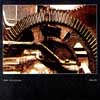 They, along with people like Christian Marclay, EmilBeaulieau, and Boyd Rice, became the first to take a turntable'sarchaic playback mechanism to task as an instrument, capable not onlyof an easily-manipulated and virtually inexhaustible bank of noise, butalso of almost automatic syntactic headfuckery. The plunderphonic,Negativlandian impulse had already begun to assert itself in 1987, butGum's purely phonographic stance brought that same brand of pop culturecommentary and exploited sound-bytes in immediate collision with thingspurely visceral. The duo scratched, sanded, baked, burnt, and otherwisemutated their thrift store finds, assembling a collection of lockedgrooves and blasted sound chips that essentially gave forgotten recordsnew life, fodder for a kind of surreal puppet circus where strung-upcorpses grind out stunted, nervous repetitions of a living dance. Gum'strajectory moves from something like a punkier incarnation of theplunderphonic phenomenon, to amateur industrial klang, to wildlysuccessful sound collage efforts that in many ways predict the soundsof today's turntable namedrops: Philip Jeck, Martin Tretault, JanekSchaefer. Curtis and Samartzis put more emphasis on the process end,that is the abrasions and mutations of the records and their preciserecombination, than on any kind of re-contextualization of recognizablesources. The few tracks to actually show their age are in fact the oneswhere the duo's intent appears too transparent, their motives too easy:phone-sex dialogue featuring Curtis set to an effected Super Fly soundtrack or a live set where the Bee Gee's Saturday Night Feverbecomes the rhythmic template. Elsewhere, the simple and arrestingpower of the duo's surface scavenges, and their queasy track titles("Testicle Stretch," "Smooth Torture in Exile," "Arm Fuck"), becomemore than adequate in communicating a hilarious, dystopian, andultimately beautiful worldview. Especially on the longer tracks like"Banning" or "Melted Limp Fallout," Gum achieves mysterious andimmersive sound environments that feel perfectly suited to the presentday and help to explain Samartzis' future work as an accomplished soundartist. Vinyl Anthology collects everything Gum released plusseveral unreleased and live tracks; it is indispensable document forfans of turntable-based music, punkers, noisers, and pop theoristsworldwide. - Andrew Culler
They, along with people like Christian Marclay, EmilBeaulieau, and Boyd Rice, became the first to take a turntable'sarchaic playback mechanism to task as an instrument, capable not onlyof an easily-manipulated and virtually inexhaustible bank of noise, butalso of almost automatic syntactic headfuckery. The plunderphonic,Negativlandian impulse had already begun to assert itself in 1987, butGum's purely phonographic stance brought that same brand of pop culturecommentary and exploited sound-bytes in immediate collision with thingspurely visceral. The duo scratched, sanded, baked, burnt, and otherwisemutated their thrift store finds, assembling a collection of lockedgrooves and blasted sound chips that essentially gave forgotten recordsnew life, fodder for a kind of surreal puppet circus where strung-upcorpses grind out stunted, nervous repetitions of a living dance. Gum'strajectory moves from something like a punkier incarnation of theplunderphonic phenomenon, to amateur industrial klang, to wildlysuccessful sound collage efforts that in many ways predict the soundsof today's turntable namedrops: Philip Jeck, Martin Tretault, JanekSchaefer. Curtis and Samartzis put more emphasis on the process end,that is the abrasions and mutations of the records and their preciserecombination, than on any kind of re-contextualization of recognizablesources. The few tracks to actually show their age are in fact the oneswhere the duo's intent appears too transparent, their motives too easy:phone-sex dialogue featuring Curtis set to an effected Super Fly soundtrack or a live set where the Bee Gee's Saturday Night Feverbecomes the rhythmic template. Elsewhere, the simple and arrestingpower of the duo's surface scavenges, and their queasy track titles("Testicle Stretch," "Smooth Torture in Exile," "Arm Fuck"), becomemore than adequate in communicating a hilarious, dystopian, andultimately beautiful worldview. Especially on the longer tracks like"Banning" or "Melted Limp Fallout," Gum achieves mysterious andimmersive sound environments that feel perfectly suited to the presentday and help to explain Samartzis' future work as an accomplished soundartist. Vinyl Anthology collects everything Gum released plusseveral unreleased and live tracks; it is indispensable document forfans of turntable-based music, punkers, noisers, and pop theoristsworldwide. - Andrew Cullersamples:
Read More

